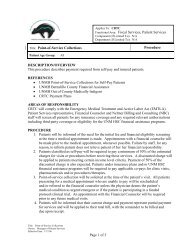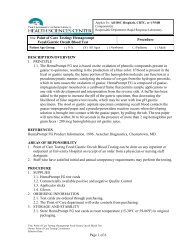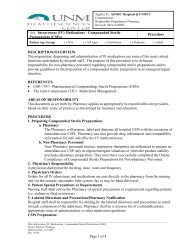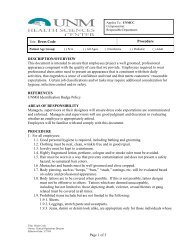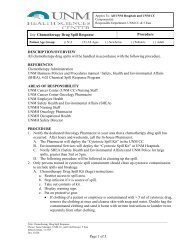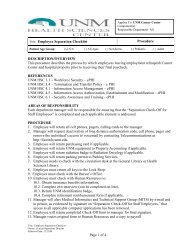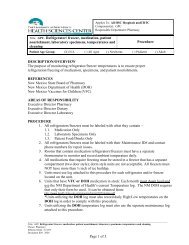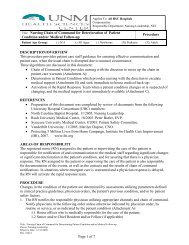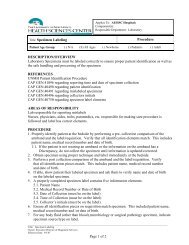Page 1 of 25 DESCRIPTION/OVERVIEW The purpose of this ...
Page 1 of 25 DESCRIPTION/OVERVIEW The purpose of this ...
Page 1 of 25 DESCRIPTION/OVERVIEW The purpose of this ...
You also want an ePaper? Increase the reach of your titles
YUMPU automatically turns print PDFs into web optimized ePapers that Google loves.
2.2. Device related infection<br />
2.3. Interventions implemented<br />
2.4. Date and time that physician was notified<br />
2.5. Annotate all VART team contacts and consultations in the medical record<br />
2.6. Assist VART team members in Quality Assurance documentation.<br />
3. Document all patient/family teaching, patient/family understanding and discharge<br />
planning in the Multidisciplinary Teaching Form and on nursing flowsheet.<br />
DEFINITIONS<br />
Central Venous Catheter (CVC) This is a catheter that is threaded through the internal jugular,<br />
antecubital, subclavian, or femoral vein usually with the tip resting in the superior vena cava or<br />
the right atrium <strong>of</strong> the heart. It is also used to administer fluids or medications. Blood may be<br />
withdrawn for diagnosis and laboratory analysis.<br />
Long Arm Catheter (LAC) This is a catheter inserted into a peripheral vein <strong>of</strong> the upper arm. It<br />
may be inserted into a central vein. This catheter is inserted by a trained RN, member <strong>of</strong> the<br />
VART team or by a physician. Blood may be drawn from any catheter larger than 3 Fr.<br />
Peripherally Inserted Central Catheter (PICC) Same as LAC.<br />
Vascular Access Resource Team (VART) This is a specially trained team <strong>of</strong> individuals who are<br />
competent with the insertion and removal <strong>of</strong> a PICC line. <strong>The</strong>re is a course designed to train<br />
individuals (nurses and doctors) who wish to do <strong>this</strong> procedure. <strong>The</strong>re is a yearly competency to<br />
check the skill level <strong>of</strong> these individuals.<br />
Venous Access Device (VAD) This is a central line that is placed in a patient under sterile<br />
conditions <strong>of</strong> an operating room or interventional radiology. It can be tunneled through the skin<br />
into the central venous circulation (broviac, groshong, or hohn) or placed in a pocket <strong>of</strong> skin on<br />
the chest (infusaport) or arm (PASport), into the central venous circulation.<br />
SUMMARY OF CHANGES<br />
1. This was changed from a policy to a procedure and placed into the new format.<br />
2. Any wording that included the use <strong>of</strong> betadine as the antiseptic skin cleanser was changed<br />
to the wording <strong>of</strong> chlorhexidine.<br />
3. Policy cross-references were increased to be more inclusion <strong>of</strong> current practices.<br />
4. A statement addressing location <strong>of</strong> patient when the venous access device was inserted<br />
was added.<br />
5. References were updated.<br />
6. Within the Attachment D: Care <strong>of</strong> the Pediatric Central Catheter, changes were made to<br />
catheter access, irrigations, frequency <strong>of</strong> dressing and needle less access cap changes, and<br />
whom to call with a central line break.<br />
7. <strong>The</strong> procedure for accessing an infusaport (portacath) has been added.<br />
8. Information regarding caring for a patient in the Post Anesthesia Care<br />
Unit (PACU) when the vascular access device was placed in the Operating Room was<br />
added.<br />
_________________________________________________________________________________________________________________<br />
Title: Venous Access Device<br />
Owner: Clinical Education Department<br />
Effective Date: 07/27/05<br />
<strong>Page</strong> 4 <strong>of</strong> <strong>25</strong>



